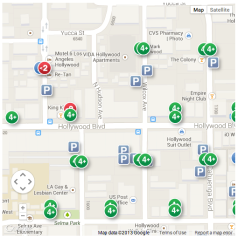A member of the Ink Factory Studio synthesizes spoken words into illustrative text and visuals during Chicago Ideas Week, in Chicago, Oct. 18, 2013.
According to the World Health Organization, the number of people living in cities is expected to almost double over the next few decades, from 3.4 billion in 2009 to 6.4 billion in 2050. And urban centers have to get a lot more efficient — in terms of energy use, food consumption, traffic management and more — to accommodate that influx. But how?
That’s the question several urban experts — including TIME’s own assistant managing editor Rana Foroohar — tackled Friday at Chicago Ideas Week, as part of the 90-minute Cities: Concrete Solutions event. Here’s the best of what they shared.
Buildings That Adapt To Our Needs — in Realtime
“I don’t think of buildings as static structures, but as living organisms” that can “talk” to us through data, said Dave Bartlett, Vice President of Smarter Physical Infrastructure at IBM. To that end, his team has helped build structures — at Tulane University, among others — with sensors on boilers, water pipes, air ducts, lights and more that monitor performance in realtime and identify potential issues before they start affecting building occupants. But that’s just step one. Imagine a movie theater whose temperature could adjust based on a crowdsourced assessment (via mobile apps) of how hot or cold its occupants were, or an office that learns to adjust its energy use around when people are working hardest. “If buildings are not helping you be more productive,” said Bartlett, “they’re not serving their purpose.”
A Parking System That’s Actually Smart
More than 30% of traffic in cities is caused by people who are looking for parking. But what if they knew exactly where to go? “That’s what we’re doing,” said Zia Yusef, president and CEO of Streetline, a company that’s worked with cities like LA and Birmingham, England, to embed thousands of sensors in street parking spots, so they can signal when they’re free. That way, users of Streetline’s mobile app — which touts a realtime map of where parking is available — can research where to park, and even pay for the space, before circling every block in the city.
But the future will be even better, Yusef added, explaining how cities are using the data they gather to create dynamic parking pricing — so you can get a guaranteed great space if you’re willing to pay a little extra — and merchants could automatically pay for your street parking as an incentive for visiting their business.
Schools That Prepare Kids For Real-Life Careers
One of the most intriguing facets of “localnomics” — the growing opportunities to boost the U.S. economy from within — is IBM’s partnership with the public schools in Brooklyn, said Foroohar, who’s also a TIME columnist. As part of the P-TECH program, high schoolers (mostly from low-income neighborhoods) spend six years not just learning STEM skills, but also interning at IBM and working with an IBM mentor. Once they graduate — with an associate’s degree and a high school diploma — they get first dibs on jobs at IBM. “It’s linking the dots between the public and private sectors,” Foroohar explained. The program, which launched at one school in 2011, is now expanding statewide in New York, and the model is already being duplicated in other cities.


